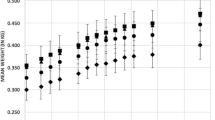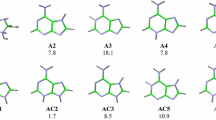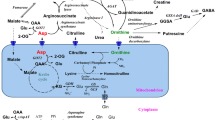Summary
After 7 weeks of oral administration of the carcinogen N-nitrosomorpholine (12 mg NNM ad 100 ml of drinking water) to male rats, marked hepatocellular changes were found predominantly in the centers of the lobules. These were loss of glycogen, disorganisation of the basophilic bodies and, sometimes, loss of cytoplasmic basophilia or pyroninophilia, necrotic cells and increase in the activity of acid DNA se and RNA se. These centrilobular alterations were reversible after withdrawal of the carcinogen. They are, therefore, attributed to the nonspecific-toxic effect of the carcinogen. In peripheral and midzonal regions of the lobules basically different cellular changes appeared which were unimportant during the phase of intoxication, but became prominent after cessation of the carcinogenic treatment. These lesions were: excessive storage of glycogen, displacement of basophilic bodies and an increase in cytoplasmic acidophilia. The hepatocytes showing these cytoplasmi changes initially formed foci. Neoplastic nodules and frank hepatocellular carcinomas developed later. During these later stages of the experiment both the foci and the nodules consisted of 4 main types of altered hepatocytes: 1) “clear” glycogen storage cells, 2) acidophilic cells, 3) vacuolated (fat storing) cells, 4) basophilic (pyroninophilic) cells poor in, or free from, glycogen. The larger nodules and carcinomas contained predominantly basophilic cells. The activity of nucleases, especially that of acid DNA se, decreased in small foci which as a rule developed later than the foci of glycogen storage. In most cells of neoplastic nodules and carcinomas the activity of these enzymes disappeared, but it reappeared in necrotic cells. The progressive alterations in the activity of the nucleases seemed to be related to the phenotypic expression of malignancy and could be a sign of a fundamental metabolic change taking place during a relatively late step in the malignant transformation.
Zusammenfassung
Die orale Gabe des Carcinogens N-Nitrosomorpholin (12 mg ad 100 ml Trinkwasser) an männliche Ratten führt innerhalb von 7 Wochen zu ausgeprägten, vorwiegend acinuszentralen Veränderungen der Hepatocyten: Glykogenschwund, Disorganisation der Ergastoplasmaschollen, in manchen Zellen Verlust der cytoplasmatischen Basophilie oder Pyroninophilie, Nekrosen, Zunahme der Aktivität der sauren DNAse und RNAse. Nach Absetzen des Carcinogens erweisen sich diese Zellveränderungen als reversibel. Sie werden daher auf die unspezifisch-toxische Wirkung des Carcinogens zurückgeführt. In peripheren und intermediären Läppchenregionen kommt es zu grundsätzlich anderen Zellveränderungen. Sie sind während der Vergiftungsphase unbedeutend, treten nach Absetzen des Carcinogens aber bei allen Tieren deutlich hervor: übermäßige Glykogenspeicherung, Dislokation der Ergastoplasmaschollen, Zunahme der cytoplasmatischen Acidophilie. Hepatocyten mit diesen Cytoplasmaalterationen bilden zunächst Herde. Später entwickeln sich neoplastische Knoten und ausgeprägte hepatocelluläre Carcinome. In den späten Versuchsstadien bestehen sowohl die Herde als auch die neoplastischen Knoten im wesentlichen aus 4 verschiedenen cellulären Schädigungstypen: 1. „Klare” Glykogenspeicherzellen, 2. acidophile Zellen, 3. vacuolisierte (fettspeichernde) Zellen, 4. glykogenarme oder -freie basophile (pyroninophile) Zellen. Größere Knoten und Carcinome enthalten vorwiegend basophile Zellen. Die Aktivität der Nucleasen, speziell der sauren DNAse, geht in anfänglich nur kleinen peripheren und intermediären Läppchenbezirken zurück. Die Herde mit veränderter Enzymaktivität bilden sich in der Regel später aus als die Glykogenspeicherherde. In neoplastischen Knoten und Carcinomen zeigen die meisten Zellen einen vollständigen Verlust der Enzymaktivität, in nekrotischen Tumorzellen tritt die Enzymaktivität aber wieder in Erscheinung. Die fortschreitenden Veränderungen der Aktivität der Nucleasen scheinen eng mit der phänotypischen Ausbildung der Malignität verknüpft zu sein. Sie könnten eine grundlegende Umstellung des Zellstoffwechsels anzeigen, die sich in einem relativ späten Stadium der neoplastischen Zelltransformation ereignet.
Similar content being viewed by others
References
Amano,H., Daoust,R.: The distribution of ribonuclease activity in rat liver during azo-dye carcinogenesis. J. Histochem. Cytochem. 9, 161–164 (1961)
Bannasch,P.: The cytoplasm of hepatocytes during carcinogenesis. Rec. Res. Cancer Res. Vol. 19. Berlin-Heidelberg-New York: Springer, 1968
Bannasch,P.: Die Cytologie der Hepatocarcinogenese. In: Handbuch der allgemeinen Pathologie, Bd. VI/7: Geschwülste III (Hrsg. H.W.Altmann et al.), pp. 123–267, Berlin-Heidelberg-New York: Springer 1975
Bannasch,P., Angerer,H.: Glykogen und Glukose-6-Phosphatase während der Kanzerisierung der Rattenleber durch N-Nitrosomorpholin. Arch. Geschwulstforsch. 43, 105–114 (1974)
Chakravorty,A.K., Busch,H.: Alkaline ribonuclease and ribonuclease inhibitor in nuclear and nucleolar preparations from normal and neoplastic tissues. Cancer Res. 27, 789–792 (1967)
Daoust,R.: Focal loss of ribonuclease activity in pre-neoplastic rat liver. Cancer Res. 32, 2502–2509 (1972)
Daoust,R., Calamai,R.: Hyperbasophilic foci as sites of neoplastic transformation in hepatic parenchyma. Cancer Res. 31, 1290–1296 (1971)
Daoust,R., Cantero,A.: The distribution of deoxyribonuclease in normal, cirrhotic and neoplastic rat liver. J.Histochem. Cytochem. 7, 139–143 (1959)
Drochmans,P., Scherer,E.: Enzyme defects in hepatocarcinogenesis. J. Cell Biol. 55, 63a (1972)
Epstein,Sh., Ito,N., Merkow,L., Farber,E.: Cellular analysis of liver carcinogenesis: the induction of large hyperplastic nodules in the liver with 2-fluorenylacetamide or ethionine and some aspects of their morphology and glycogen metabolism. Cancer Res. 27, 1702–1711 (1967)
Forget,A., Daoust,R.: Histochemical study of rat liver glycogen during DAB carcinogenesis. Int. J. Cancer 5, 404–409 (1970)
Fort,L., Taper,H.S., Brucher,J.M.: Gastric carcinogenesis in rat induced by methylnitrosourea (MNU). Morphology and histochemistry of nucleases. Z. Krebsforsch. 81, 51–62 (1974)
Friedrich-Freksa,H., Gössner,W., Börner,P.: Histochemische Untersuchungen der Cancerogenese in der Rattenleber nach Dauergaben von Diäthylnitrosamin. Z. Krebsforsch. 72, 226–239 (1969)
Goldfarb,St.: A morphological and histochemical study of carcinogenesis of the liver in rats fed 3′-methyl-4-dimethylaminoazobenzene. Cancer Res. 33, 1119–1128 (1973)
Hobik,H.P., Grundmann,E.: Quantitative Veränderungen der DNS und RNS in der Rattenleberzelle während der Carcinogenese durch Diäthylnitrosamin. Beitr. Path. Anat. 127, 25–48 (1962)
Kitagawa,T.: Histochemical analysis of hyperplastic lesions and hepatomas of the liver of rats fed 2-fluorenylacetamide. Gann 62, 207–216 (1971)
Kurnick,N.B., Schwartz,L., Pariser,S., Lee,S.: A specific inhibitor of human desoxyribonuclease and an inhibitor of the Lupus Erythematosus cell phenomenon from leucocytes. J. clin. Invest. 32, 193–201 (1953)
Moulin,M.Ch., Daoust,R.: Glucose-6-phosphatase activity in rat liver parenchyma during azo-dye carcinogenesis. Int. J. Cancer 8, 81–85 (1971)
Nago,M., Ichikawa,Y.: Systemic effect of mouse leukemia on RNase and its inhibitor of host liver and spleen. Gann 60, 279–285 (1969)
Nemoto,N., Takayama,S.: Rapid loss of 7-methylguanidine from liver nucleic acids in mice during the initial stage of liver carcinogenesis induced by dimenthylnitrosamine. Biochem. biophys. Res. Commun. 58, 242–249 (1974)
Roth,J.S.: Some observations on the assay and properties of ribonucleases in normal and tumor tissues. In: Methods in Cancer Research, Vol. 3 (ed. H.Busch), pp. 153–242. London-New York: Academic Press 1967
Schauer,A., Kunze,E.: Enzymhistochemische und autoradiographische Untersuchungen während der Cancerisierung der Rattenleber mit Diäthylnitrosamin. Z. Krebsforsch. 70, 252–266 (1968)
Schmitz-Moormann,P., Gedick,P., Dharamandhach,A.: Histologische und histochemische Frühveränderungen bei der experimentellen Erzeugung von Lebercarcinomen durch Diäthylnitrosamin. Z. Krebsforsch. 77, 9–16 (1972)
Schulze,B.: Wechselbeziehungen zwischen Lysosomen und Zellkern bei der Diäthylnitrosamin-Carcinogenese. I. Änderung der subzellulären Verteilung der lysosomalen Enzyme saure Desoxyribonuclease und β-d-Galaktosidase nach akuter Diäthylnitrosamin-Intoxikation. Z. Krebsforsch. 79, 241–248 (1973)
Squire,R.A., Levitt,M.: Report of a workshop on classification of specific hepatocellular lesions in rats. Cancer 35, 3214–3223 (1975)
Taper,H.S.: L'activité des nucléases et phosphatases acides et alcalines dans les tumeurs rénales induites chez le rat par la diméthylnitrosamine (Etude histochimique). Path, europ. 4, 406–420 (1967)
Taper,H.S.: La détection histochimique de la désoxyribonucléase alcaline. Ann Histochim. 14, 301–317 (1968)
Taper,H.S., Brucher,J.M., Fort,L.: Activity of alkaline and acid nucleases in tumors of the human central nervous system. Histochemical study. Cancer 28, 482–490 (1971a)
Taper,H.S., Fort,L., Brucher,J.M.: Histochemical activity of alkaline and acid nuclease in rat liver parenchyma during N-nitrosomorpholine carcinogenesis. Cancer Res. 31, 913–916 (1971b)
Tempel,K., Hollatz,R.: Desoxyribonucleasen und Phosphatasen der Rattenleber nach Cancerisierung durch Diäthylnitrosamin. Z. Krebsforsch. 79, 267–272 (1973)
Theodossiou,A., Bannasch,P., Reuss,W.: Glykogen und endoplasmatisches Reticulum der Leberzelle nach hohen Dosen des Carcinogens N-Nitrosomorpholin. Virchows Arch. Abt. B. 7, 126–146 (1971)
Vorbrodt,A.: Histochemical studies on the intracellular localization of acid deoxyribonuclease. J. Histochem. Cytochem. 9, 647–655 (1961)
Author information
Authors and Affiliations
Additional information
This investigation was supported by a research visitors' grant of Deutsches Krebsforschungszentrum Heidelberg (Germany) and by Fonds de la Recherche Scientifique Médicale (Belgium)
Rights and permissions
About this article
Cite this article
Taper, H.S., Bannasch, P. Histochemical correlation between glycogen, nucleic acids and nucleases in pre-neoplastic and neoplastic lesions of rat liver after short-term administration of N-nitrosomorpholine. Z. Krebsforsch. 87, 53–65 (1976). https://doi.org/10.1007/BF00285074
Received:
Accepted:
Issue Date:
DOI: https://doi.org/10.1007/BF00285074




